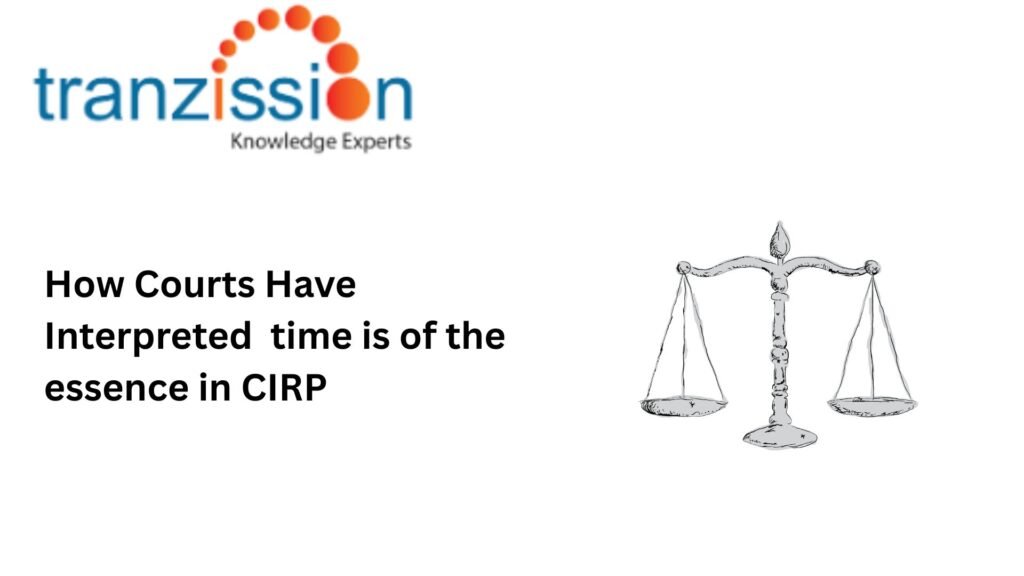
How Courts Have Interpreted time is of the essence in CIRP

Table of Contents
The Insolvency and Bankruptcy Code, 2016 (“the IBC”) emphasises time is of the essence in CIRP -bound resolution of the financial difficulties. The prescribed timelines are not merely procedural, they are integral to achieving the IBC’s broader objectives. This article covers the judicial interpretation of the necessity and potential challenges of timely resolution under the IBC.
Understanding time is of the essence in CIRP
The IBC specifies timelines for various steps in the CIRP, including the initial 180 day period under section 12, and a possible extension of 90 days. If the resolution process is not completed within these timelines, the National Company Law Tribunal (NCLT) can initiate liquidation. time is of the essence in CIRP also applies to the submission and approval of resolution plans. The CoC and the resolution applicant must adhere to the timelines for submitting resolution plas, and the NCLT must decide on the resolution plan within the prescribed time frame.
Read more : Legal consequences of misrepresentation in insolvency petitions
Judicial Interpretations:
In Kridhan Infrastructure Pvt. Ltd. v. Venkestesan Sankaranarayan & Ors,the Supreme Court affirmed the critical importance of timely and bona fide execution of resolution plans under the IBC, recognising that time is of the essence in CIRP in insolvency proceedings. The court upheld a liquidation order because the resolution applicant failed to comply with the terms of the approved plan, reinforcing the IBC’s aim for efficient and timely resolution.
This decision highlights the court’s role in ensuring the objectives are met and that resolution applicants adhere to their obligations, promoting accountability and integrity within the process. Further in Committee of Creditors of Amtek Auto Ltd. v. Dinkar T. Venkatsubramanian held that the entire resolution process has to be to be completed within the period stipulated under Section 12 of the IBC and any deviation would defeat the object and purpose of providing such time limit.
In the Siva Industries and Holdings Ltd case, the NCLT rejected the company’s settlement offer under section 12A, citing ambiguity and the fact that it was a “business restructuring plan” rather than a true settlement, and ordered liquidation. The NCLT’s decision highlighted the importance of clear and unambiguous settlement proposals under the IBC , and it also raised questions about the “commercial wisdom” of the Committee of Creditors (CoC) in similar cases.
Flexibility in Exceptional Circumstances
Courts can allow extensions beyond the standard 330-day time is of the essence in CIRP, but these extensions are subject to specific criteria and have significant implications. The primary goal is to facilitate a successful resolution rather than liquidation, but extensions must be sought through proper judicial approval and are limited to a one-time extension of up to 90 days.
Implications for Stakeholders
The timelines and the resolution process have implications for all stakeholders, including creditors, debtors, and resolution professionals:
- Financial and operational creditors have a vested interest in ensuring a time is of the essence in CIRP resolution to recover their dues.
- Delays can lead to uncertainty about job security and potential loss of compensation.
- The outcome of the resolution processed directly impacts their equity, and the resolution plan can potentially affect their future involvement in the company.
- Resolution professionals must proactively manage any potential delays and ensure they are justified, within the permissible limits.
- Resolution professionals must submit regular updates and communication with the CoC and other stakeholders to ensure transparency and maintain trust.
Conclusion
Timely completion of the resolution process is deeply ingrained in the IBC and has been consistently affirmed by the judiciary. Prolonged delays in CIRP can undermine the objective of resolution and lead to uncertainty for all stakeholders. The Supreme Court has noted the delays can also dilute the objective of resolution under the IBC. The emphasis on timelines is crucial for achieving the IBC’s objectives of efficient resolution, maximising asset value, and bolstering creditor confidence.





